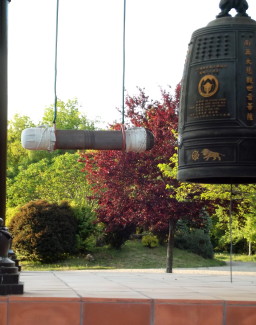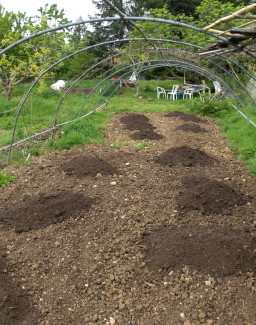We now offer the cheapest Rock Dust in the UK
As of this sunny morning here in Wales we are now offering the cheapest Volcanic Rock Dust in easy to carry bags in the UK.
April 2014 The Bergerac region of south west France saw the first installation of HH-2 The Plum Village Buddhist community are located here with 3 farms. The Good Gardeners HH-2 system of fertility making had been spotted on the internet by the funders of the Plum Village community; the wealthy Astor family. Under their instruction the first HH-2 system was ordered and shipped to France.
The Plum Village Buddhist community are located here with 3 farms. The Good Gardeners HH-2 system of fertility making had been spotted on the internet by the funders of the Plum Village community; the wealthy Astor family. Under their instruction the first HH-2 system was ordered and shipped to France.



This hugely successful community are Vegans and thus respect all animal life. They grow a lot of their own food and want to grow more. Previously they had been buying commercially produced compost for their poly tunnels but this had not stopped the onslaught of pests and diseases. A meeting was called for members of their three farms to attend. The aim being to generate an optimum fertiliser/soil conditioner from their own waste know as HH-4
but this had not stopped the onslaught of pests and diseases. A meeting was called for members of their three farms to attend. The aim being to generate an optimum fertiliser/soil conditioner from their own waste know as HH-4
![]()
![]()
![]()
![]()

With their large number of visitors each summer (500) they were easily able to sanitize the entire site with no expensive infrastructure and return the waste (organic matter) to the soil with TNR total nutrient recovery in the most efficient way via the HH-2 technology.
The operators course was given over a few days and the staff soon mastered the ancient science of organic waste management as practised by the Chinese 5,000 years ago.
They were able to add more toilet housings quickly that housed the same HH-3 equipment. This is all above ground so poses no risk to contaminating the water table.
In conjunction with all their kitchen waste and crop waste, grass cutting etc., they soon had a closed loop system of fertilising their crops and maintaining a permanent sustainable solution to building their soil and protecting their environment.
This is a living example of how to manage a communities waste responsibly without using up valuable water resources that are becoming increasingly rare today and without leaving the fateful job of emptying pit latrines or septic tanks to someone else.
Thus there is no storage of human effluent left to fester, breed rats and flies and pollute water tables. This is one of the surest ways to improve the health of any community and prevent the spread of deadly diseases which come from unattended sanitation waste. see full article in ON LOCATION
As of this sunny morning here in Wales we are now offering the cheapest Volcanic Rock Dust in easy to carry bags in the UK.
BBC Farming Today exposes the scandal of contaminated salad crops in the UK. Simple answer: Don’t use raw manure to produce your salad crops or

| Cookie | Duration | Description |
|---|---|---|
| cookielawinfo-checkbox-advertisement | 1 year | The cookie is set by GDPR cookie consent to record the user consent for the cookies in the category "Advertisement". |
| cookielawinfo-checkbox-analytics | 11 months | This cookie is set by GDPR Cookie Consent plugin. The cookie is used to store the user consent for the cookies in the category "Analytics". |
| cookielawinfo-checkbox-functional | 11 months | The cookie is set by GDPR cookie consent to record the user consent for the cookies in the category "Functional". |
| cookielawinfo-checkbox-necessary | 11 months | This cookie is set by GDPR Cookie Consent plugin. The cookies is used to store the user consent for the cookies in the category "Necessary". |
| cookielawinfo-checkbox-others | 11 months | This cookie is set by GDPR Cookie Consent plugin. The cookie is used to store the user consent for the cookies in the category "Other. |
| cookielawinfo-checkbox-performance | 11 months | This cookie is set by GDPR Cookie Consent plugin. The cookie is used to store the user consent for the cookies in the category "Performance". |
| elementor | never | This cookie is used by the website's WordPress theme. It allows the website owner to implement or change the website's content in real-time. |
| viewed_cookie_policy | 11 months | The cookie is set by the GDPR Cookie Consent plugin and is used to store whether or not user has consented to the use of cookies. It does not store any personal data. |
| Cookie | Duration | Description |
|---|---|---|
| mailchimp_landing_site | 1 month | The cookie is set by the email marketing service MailChimp. |
| Cookie | Duration | Description |
|---|---|---|
| _ga | 2 years | This cookie is installed by Google Analytics. The cookie is used to calculate visitor, session, campaign data and keep track of site usage for the site's analytics report. The cookies store information anonymously and assign a randomly generated number to identify unique visitors. |
| _gat_gtag_UA_203491877_1 | 1 minute | This cookie is set by Google and is used to distinguish users. |
| _gat_UA-203491877-1 | 1 minute | This is a pattern type cookie set by Google Analytics, where the pattern element on the name contains the unique identity number of the account or website it relates to. It appears to be a variation of the _gat cookie which is used to limit the amount of data recorded by Google on high traffic volume websites. |
| _gid | 1 day | This cookie is installed by Google Analytics. The cookie is used to store information of how visitors use a website and helps in creating an analytics report of how the website is doing. The data collected including the number visitors, the source where they have come from, and the pages visted in an anonymous form. |
| CONSENT | 16 years 4 months | These cookies are set via embedded youtube-videos. They register anonymous statistical data on for example how many times the video is displayed and what settings are used for playback.No sensitive data is collected unless you log in to your google account, in that case your choices are linked with your account, for example if you click “like” on a video. |
| Cookie | Duration | Description |
|---|---|---|
| IDE | 1 year 24 days | Used by Google DoubleClick and stores information about how the user uses the website and any other advertisement before visiting the website. This is used to present users with ads that are relevant to them according to the user profile. |
| test_cookie | 15 minutes | This cookie is set by doubleclick.net. The purpose of the cookie is to determine if the user's browser supports cookies. |
| VISITOR_INFO1_LIVE | 5 months 27 days | This cookie is set by Youtube. Used to track the information of the embedded YouTube videos on a website. |
| YSC | session | This cookies is set by Youtube and is used to track the views of embedded videos. |
| yt-remote-connected-devices | never | These cookies are set via embedded youtube-videos. |
| yt-remote-device-id | never | These cookies are set via embedded youtube-videos. |
| yt.innertube::nextId | never | These cookies are set via embedded youtube-videos. |
| yt.innertube::requests | never | These cookies are set via embedded youtube-videos. |
| Cookie | Duration | Description |
|---|---|---|
| cookies.js | session | No description available. |
| wp_woocommerce_session_7ef5404579515d013e9154529f907a7f | 2 days | No description |